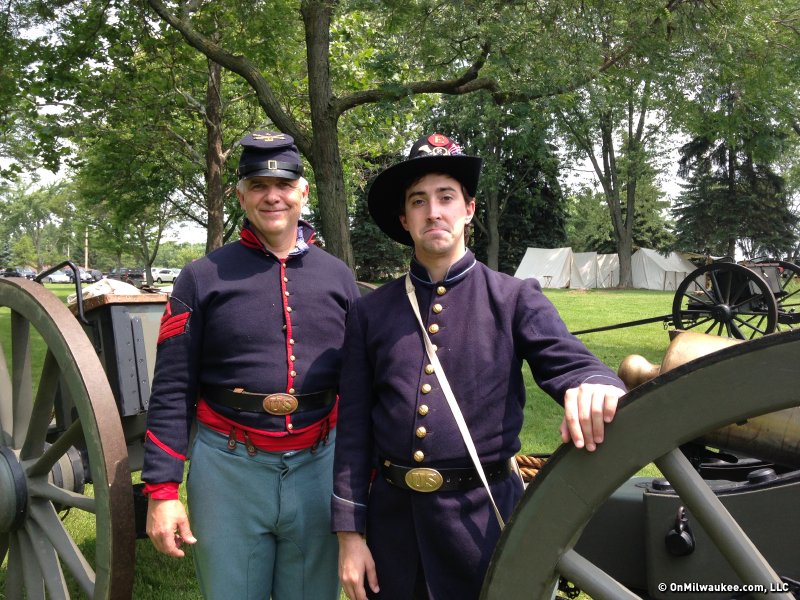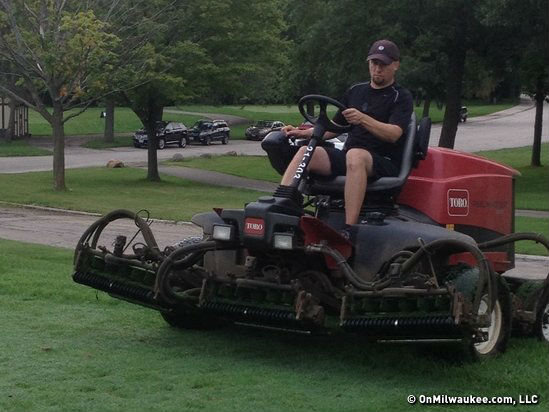Every now and then, the writers here at OnMilwaukee.com decide to give other, unique jobs a try.
Managing editor Bobby Tanzilo, for instance, worked as a cheesemaker for a day, a record store clerk and harvested soybeans. Publisher Andy Tarnoff spent a day with a Milwaukee police officer on the K-9 unit. Senior writer Molly Snyder has sampled careers as a magician’s assistant, diaper washer (a job that somehow exists and is a thing) and most recently, a role in the Milwaukee Ballet’s "The Nutcracker."
Me? Well, I recently fought in the Civil War.
No, I didn’t finagle my way into purchasing a time machine. Instead, I spent my last Sunday all dressed up in my 19th century best, participating in a Civil War encampment (and ice cream social!) at Old Falls Village in Menomonee Falls. I even found myself envisioning the whole world in sepia tone, narrating letters out loud like a Ken Burns PBS documentary and using the word "fortnight" in regular conversation – though the not exactly period accurate bouncy castle at the attached ice cream social somewhat shot a musket hole in my immersion.
I’d always had a mild personal connection to the world of Civil War reenactments. My uncle has several years participating in these encampments as a hobby, and growing up on the border of Hales Corners and Greenfield, I remember waking up some late summer mornings to the sound of echoing musket fire (totally not unnerving at all) at an encampment at nearby Trimborn Farm. It’s always been on the outskirts of my life, so when I found out about the upcoming event at Old Falls Village, I had to give it a go (even though it's not a job; everyone participating is a volunteer, there for the love of community, history and possibly black powder).
I showed up at about 9:30 Sunday morning and walked through some of the simple Civil War-era tents scattered across the park grounds. People were all in their uniforms or their period appropriate garb, tending to fires, eating an early lunch and hanging out.
After meeting some of my fellow comrades in arms, I was quickly whisked away to get a uniform. Early on, one of the event’s coordinators Nancy Greifenhagen asked me if I had any preference on a side. I said the Union, because as much as I usually love siding with the underdog, it helps if they’re not racist.
I got a heavy, button-up and not-at-all-slimming blue wool jacket (perfect for a hot summer day!), a belt with cap pouch and bayonet sheath – complete with bayonet – and a black hat, all which had to be bought by those participating. Like most hobbies, to participate, you have to spend the money.
However, Civil War reenacting actually qualifies as a tax write-off since it technically is an educational service. Almost everyone participating in the encampment was a history buff, ready to answer questions about their period-authentic gear. Making up answers is a big no-no, and electronic devices are out of sight, though with a close look, you could see a Kindle or cell phone sticking out of a wicker basket or hidden away on a table. Phew, I thought, I wouldn’t have to take my notes via parchment and quill pen.
Fellow Union fighter Scott Blood, in his second year of reenacting, explained the various symbols on my hat. The horn meant I was a member of the infantry, while the E and 2 identified me as a member of the 2nd Wisconsin, Company E.
It may be participating in a fake battle, but everything in it is very real, down to the details. Some guests aren’t convinced, leading to bafflingly brain-dead questions like "Is that a real baby?" and "Is that a real fire?"
Now all outfitted up, Scott and I walked back to the tents. The infantry’s tents were nothing more than little white pup tents, maybe only a little taller than waist high (the higher ranking officials and artillery men had larger, roomier tents). As Scott informed me, back in Civil War times, the men were much shorter, maybe 5-6 to 5-8 on average. And yes, they do sleep overnight in them. After hours, with the patrons gone, cell phones and electronic devices are fine.
I chatted some more with the Union guys, learning about how long they’d participating in these sorts of encampments and what kind of activities I was in for today. Some had been doing it for decades. Others were participating in just their second or third event. Several had recently gone down to Gettysburg for a massive 150th anniversary encampment/reenactment there.
Most of the reenactors were about middle-aged – likely because they're at the age where they can afford the period authentic uniforms, muskets and equipment needed to participate – though there were plenty of kids around as well. The Union’s drum and fife players were 16-year-old identical twin brothers Andrew and Anthony Burzinski. They started all the way back as 12-year-olds just because it seemed cool and interesting.
Later in the day, I ran into a group of young female reenactors playing Hoops and Graces, an old game involving two thin sticks and a ribbon-covered hoop that was meant to teach young women how to be more graceful. I did very poorly. There is a points system, though it seemed akin to the points on "Whose Line Is It Anyway?". After spending a few minutes slinging the hoop around and incompetently stabbing at the air trying to hook the hoop, I have no idea how this was a game about grace. Watching two people play Dance Dance Revolution after knocking back several cases of PBR is more graceful.
Eventually, it became time for infantry drills. I was handed a musket, and it was time to march. Early on, it went somewhat easily. The moves were fairly simple, marching in step with my fellow infantrymen and shifting my musket to the appropriate positions shouted by the captain. "I might actually have the hang of this," I thought, "I might even look cool blending in with these guys."
Oh, poor poor optimistic me.
There are several different Civil War manuals, as well – all written back during actual wartime. So are we following Gilham’s manual? Baxter’s? Hardee’s? Casey’s? Even the longtime reenactors were debating various positions and what orders really meant.
But nobody looked more hilariously out of place than me, fumbling to put my hands on the right spots on the musket, handing the gun out wrong, needing several of the guys around me to put me in the right spot and just generally looking like a mess. If we were fighting in an actual war, I would’ve made a wonderful meat shield.
It was still fun – and the guys were all very patient with my incompetent self – but in actual fake combat, someone like me could be a hazard. The men fire their muskets in tight two line formations, with the back row’s weapons close to the front row’s head. The barrel needs to be in the right spot. If a head is too close to the hammer, the person will go deaf; if it’s too close to the end of the barrel, the powder and flash could make you go blind. Just because there are no bullets involved doesn’t mean reenacting is danger-free.
I was relieved – though probably not as relieved as the soldiers around me – when I was eventually summoned away from the infantry unit and into the artillery, where reenactor – and conveniently my uncle – Chris Bestul took me through the ropes. He also kindly bought me a period authentic lunch of hot dogs and a fun size bag of Fritos.
Now, the artillery is where it’s at. They get bigger tents for sleeping, and they have fewer intricate orders to remember. But most importantly, they get to fire the big gun: the cannon.
Our unit’s cannon was a legitimate Civil War tube, too (the woodwork was all newly built). Up front, the loud bronze relic came marked with its manufacturing date (1863), its weight (over 12,000 pounds), its inspection number, its inspector’s initials, the name of Paul Revere’s company and a dent left from a musket. And, for some odd reason, they were going to fill it with a brick of black powder and let me fire this thing off.
My position on the big gun was No. 3, to the back and right of the cannon. I was given a brown leather sheath for my left thumb and what appeared to be an oversized metal toothpick in a leather pouch.
Using the leather thumb sock, I was to cover the vent at the end of the cannon while it was being cleaned, loaded and prepped. This made sure no extra oxygen got into the tube, blowing around black powder, letting in debris and lighting up leftover embers. After that, it was my job to "poke and prime" the powder, taking my fancy pick, shoving it into the vent and puncturing the powder. I’d then take the primer from the man (position number 4) across from me, and once he properly measured out the rope, I’d put what was essentially the detonator into the vent, back away, cover my ears and hope for a boom.
My jobs were simple but stressful. We were still dealing with black powder and a monumental amount of force. One ember starts lighting up around black powder from some oxygen let in or an unstraightened primer, and suddenly our fake battle would deliver wounds similar to a real one. One gentleman told me during Civil War cannon training, they show you a video of a man getting viciously destroyed by a shot gone awry. A confidence builder if I ever heard one.
And if that wasn’t enough, keeping a thumb on the vent hurt. There’s a special way one is supposed to guard the vent, and it’s not kind to the joints. Push your thumb into the desk or table you’re sitting at with your thumb facing you. Make it so that your elbow makes a 90 degree angle and your arm is parallel to the table. Do this for several minutes. Uncomfortable, right? Now, imagine that if you don’t press strong enough, your desk or table could explode, killing or at least quite charring those around you. Now you’re tense AND uncomfortable, a perfect combo! Safe to say my thumb is still stiff.
Even with all of that, though, our two practice shots went off without a hitch. And boy, that big boom is quite addictive. Luckily, we’d get to fire a few more off later – in the actual battle.
According to Chris, our particular battle would be one around Winchester, Vir. from July 19, 1864. Confederate General AP Hill had just retreated from Washington D.C., sneaking away from a superior force placed there at the last minute by General Grant. Our Union troops were trying to stop Hill’s troops from reuniting with Robert E. Lee and reinforcing his troops at Richmond.
We took the two sides of the battlefield, all while a crowd of spectators, costumed picnic-ers with parisols and a brass band watched across the way. My fellow battery men talked about other Civil War battles while waiting for the Confederates to storm in. Soon enough, there they were, marching in unison toward our Union cavalry and infantry. Muskets started blasting, and that was our cannon’s cue.
We took our positions, as my mind frantically cycled through my few – but crucial – steps. Put on your equipment (why is the leather thumb piece not cooperating with me!?) Okay, put the thumb on the vent. Press down. Press harder. PRESS HARDER! Okay, prime the charge. Please don’t blow up. Wait for the number four guy. Hold the primer. Put the primer in. Is it good to go? I hope it’s good to go. Nod at the unit commander. Turn away. Cover your ear. Pray. Pray. Don’t stop praying…
Ka-BOOM!
A successful shot! No time to celebrate though. The thumb went back on the vent, and we loaded up another round. Prick, prime and BOOOOOOM! It was a perfect shot; no early boom or anything. Just one solid, loud, booming eruption of awesome power. I looked over at Chris, who said we should run back to the lumber, also known as our wooden equipment box. We got back there, muskets erupting in the background as we surveyed the field. The Confederate cannon went off across the green, and Chris looked at me.
"And now we die," he said. Then he made a quick "AGGGH!" yell and slowly slumped to the ground. Historically, the Union lost this particular fight, so we had to die. The exact moves and details may not be planned to an absolute T, but the end results are mostly scripted.
Lying dead on the very buggy field, I could hear the musket fire die away and slowly turn into the sound of Confederate survivors taking Union prisoners. All the while, my final thoughts turned into a melancholy letter from a Ken Burns documentary.
Dearest Agatha,
I regret to say I will be unable to return to your sweet visage in time for Christmas. I have been wounded to a regrettable level on the battlefield, and the doctor is yet a fortnight’s carriage ride away. Damn this Virginia swamp, and damn this ungodly war. I will truly, deepl…
Oh, the crowd’s applauding. Never mind; the show’s over. Time to get up, get some ice cream and have a go in the bouncy castle.
I took off those sweaty woolen clothes and said goodbye to my fellow compatriots, who were basking in the glow of a battle well fought (even if we, the artillery, were little whiny about only being able to fire two of our prepared four shots. Turns out the Union was just too eager to retreat and die).
Most of them try to hit about one of these events a month. Even before this event had ended, several of them were already talking about the next one, Old World Wisconsin in August. There, members of the 2nd Wisconsin Infantry will be back at it, catching up with old friends and maybe even making some new ones too. I was told multiple times that they're always looking for more enlistees to commit and join the ranks.
For me, dying in one Civil War was likely enough – and I'm still trying to loosen up my thumb. But for one day, I had a blast – literally and figuratively.
As much as it is a gigantic cliché to say that one has always had a passion for film, Matt Mueller has always had a passion for film. Whether it was bringing in the latest movie reviews for his first grade show-and-tell or writing film reviews for the St. Norbert College Times as a high school student, Matt is way too obsessed with movies for his own good.
When he's not writing about the latest blockbuster or talking much too glowingly about "Piranha 3D," Matt can probably be found watching literally any sport (minus cricket) or working at - get this - a local movie theater. Or watching a movie. Yeah, he's probably watching a movie.







